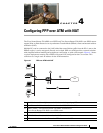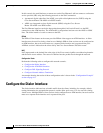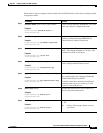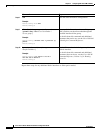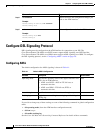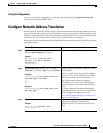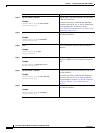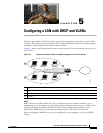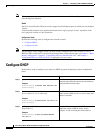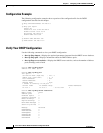
4-7
Cisco Secure Router 520 Series Software Configuration Guide
OL-14210-01
Chapter 4 Configuring PPP over ATM with NAT
Configure Network Address Translation
Verify the Configuration
You can verify that the configuration is set the way you want by using the show dsl interface atm
command from privileged EXEC mode.
Configure Network Address Translation
Network Address Translation (NAT) translates packets from addresses that match a standard access list,
using global addresses allocated by the dialer interface. Packets that enter the router through the inside
interface, packets sourced from the router, or both are checked against the access list for possible address
translation. You can configure NAT for either static or dynamic address translations.
Perform these steps to configure the outside ATM WAN interface with dynamic NAT, beginning in global
configuration mode:
Command Purpose
Step 1
ip nat pool name start-ip end-ip {netmask
netmask | prefix-length prefix-length}
Example:
Router(config)# ip nat pool pool1
192.168.1.0 192.168.2.0 netmask
255.255.255.0
Router(config)#
Creates pool of global IP addresses for NAT.
Step 2
ip nat inside source {list access-list-number}
{interface type number | pool name} [overload]
Example 1:
Router(config)# ip nat inside source list 1
interface dialer 0 overload
or
Example 2:
Router(config)# ip nat inside source list
acl1 pool pool1
Enables dynamic translation of addresses on the
inside interface.
The first example shows the addresses permitted
by the access list 1 to be translated to one of the
addresses specified in the dialer interface 0.
The second example shows the addresses
permitted by access list acl1 to be translated to
one of the addresses specified in the NAT pool
pool1.
For details about this command and additional
parameters that can be set, as well as information
about enabling static translation, see the
Cisco IOS IP Command Reference, Volume 1 of 4:
Addressing and Services.
Step 3
interface type number
Example:
Router(config)# interface vlan 1
Router(config-if)#
Enters configuration mode for the VLAN (on
which the Fast Ethernet LAN interfaces
[FE0–FE3] reside) to be the inside interface for
NAT.





